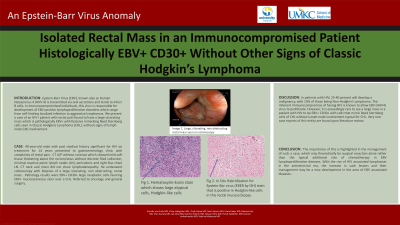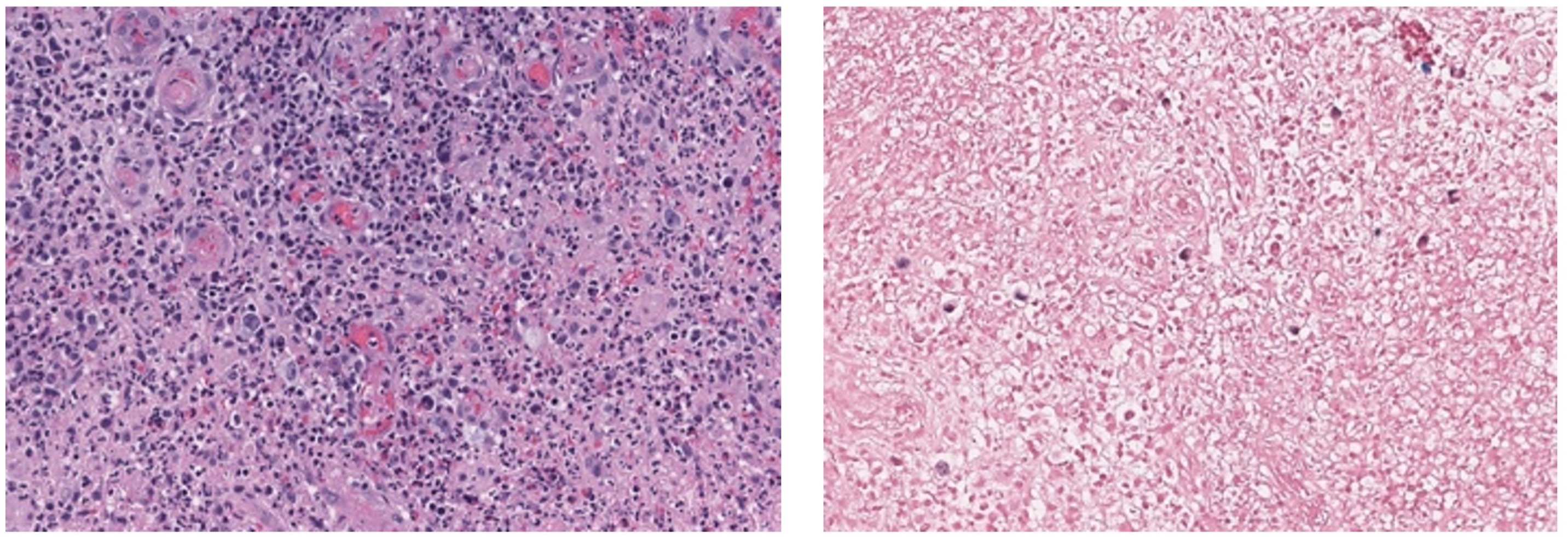Sunday Poster Session
Category: Colon
P0279 - An Epstein Anomaly
Sunday, October 22, 2023
3:30 PM - 7:00 PM PT
Location: Exhibit Hall

Has Audio
- Jv
Jennifer von Ende, MD
University of Missouri Kansas City
Kansas City, MO
Presenting Author(s)
Award: Presidential Poster Award
Jennifer von Ende, MD1, Vinay Jahagirdar, MD2, Hassan Ghoz, MD2
1University of Missouri Kansas City, Kansas City, MO; 2University of Missouri-Kansas City, Kansas City, MO
Introduction: Epstein-Barr Virus (EBV), known also as Human Herpesvirus 4 (HHV 4) is transmitted via oral secretions and tends to infect B cells. In immunocompromised individuals, this virus is responsible for development of EBV positive lymphoproliferative disorders which range from self-limiting localized infection to aggressive lymphomas. We present a case of an HIV+ patient with rectal pain found to have a large ulcerating mass which is pathologically EBV+ with features mimicking Reed Sternberg cells seen in CHL, without signs of lymph node involvement characteristic of CHL.
Case Description/Methods: A 40-year-old male with past medical history significant for HIV on treatment for 14 years with CD4 count of 324, presented to gastroenterology (GI) clinic with complaints of rectal pain. He was evaluated by general surgery for purulent rectal drainage and pain 4 months prior and underwent rectal exam under sedation with fistulotomy, excision of condyloma acuminatum and mucosal biopsy of an ulcer at that time. Pathology results were EBV+ CD30+ large neoplastic cells favoring EBV+ mucocutaneous ulcer over a CHL (fig 1,2). CT abdomen/pelvis (A/P) was subsequently done showing minimal reactive pelvic, pericolonic and right iliac chain lymph nodes (LN). CT neck and chest did not show lymphadenopathy.
Eight days prior to GI evaluation, he had a repeat CT A/P without contrast which showed mild soft tissue thickening about the rectum/anus without discrete fluid collection. GI then performed esophagogastroduodenoscopy and colonoscopy with repeat biopsies of a large ulcerating, non obstructing, rectal mass which again had the same pathology findings as noted previously. He will follow with general surgery and oncology to determine the plan moving forward.
Discussion: In patients with HIV, 25-40 percent will develop a malignancy, with 10% of those being Non-Hodgkin’s Lymphoma. The inherent immunocompromise of having HIV is known to allow EBV (HHV4) virus to proliferate. However, it is exceedingly rare to see a large mass in a patient with HIV to be EBV+CD30+ with cells that mimic Reed Sternberg cells of CHL without lymph node involvement typical for CHL. Very rare case reports of this entity are found upon literature review. The importance of this is highlighted in the management of such a case, which may theoretically be surgical resection alone rather than the typical additional role of chemotherapy in EBV lymphoproliferative diseases.

Disclosures:
Jennifer von Ende, MD1, Vinay Jahagirdar, MD2, Hassan Ghoz, MD2. P0279 - An Epstein Anomaly, ACG 2023 Annual Scientific Meeting Abstracts. Vancouver, BC, Canada: American College of Gastroenterology.
Jennifer von Ende, MD1, Vinay Jahagirdar, MD2, Hassan Ghoz, MD2
1University of Missouri Kansas City, Kansas City, MO; 2University of Missouri-Kansas City, Kansas City, MO
Introduction: Epstein-Barr Virus (EBV), known also as Human Herpesvirus 4 (HHV 4) is transmitted via oral secretions and tends to infect B cells. In immunocompromised individuals, this virus is responsible for development of EBV positive lymphoproliferative disorders which range from self-limiting localized infection to aggressive lymphomas. We present a case of an HIV+ patient with rectal pain found to have a large ulcerating mass which is pathologically EBV+ with features mimicking Reed Sternberg cells seen in CHL, without signs of lymph node involvement characteristic of CHL.
Case Description/Methods: A 40-year-old male with past medical history significant for HIV on treatment for 14 years with CD4 count of 324, presented to gastroenterology (GI) clinic with complaints of rectal pain. He was evaluated by general surgery for purulent rectal drainage and pain 4 months prior and underwent rectal exam under sedation with fistulotomy, excision of condyloma acuminatum and mucosal biopsy of an ulcer at that time. Pathology results were EBV+ CD30+ large neoplastic cells favoring EBV+ mucocutaneous ulcer over a CHL (fig 1,2). CT abdomen/pelvis (A/P) was subsequently done showing minimal reactive pelvic, pericolonic and right iliac chain lymph nodes (LN). CT neck and chest did not show lymphadenopathy.
Eight days prior to GI evaluation, he had a repeat CT A/P without contrast which showed mild soft tissue thickening about the rectum/anus without discrete fluid collection. GI then performed esophagogastroduodenoscopy and colonoscopy with repeat biopsies of a large ulcerating, non obstructing, rectal mass which again had the same pathology findings as noted previously. He will follow with general surgery and oncology to determine the plan moving forward.
Discussion: In patients with HIV, 25-40 percent will develop a malignancy, with 10% of those being Non-Hodgkin’s Lymphoma. The inherent immunocompromise of having HIV is known to allow EBV (HHV4) virus to proliferate. However, it is exceedingly rare to see a large mass in a patient with HIV to be EBV+CD30+ with cells that mimic Reed Sternberg cells of CHL without lymph node involvement typical for CHL. Very rare case reports of this entity are found upon literature review. The importance of this is highlighted in the management of such a case, which may theoretically be surgical resection alone rather than the typical additional role of chemotherapy in EBV lymphoproliferative diseases.

Figure: A. Hematoxylin + Eosin (H+E), B. Ebstein Barr encoding region (EBER) In- situ hybridization (ISH)
Disclosures:
Jennifer von Ende indicated no relevant financial relationships.
Vinay Jahagirdar indicated no relevant financial relationships.
Hassan Ghoz indicated no relevant financial relationships.
Jennifer von Ende, MD1, Vinay Jahagirdar, MD2, Hassan Ghoz, MD2. P0279 - An Epstein Anomaly, ACG 2023 Annual Scientific Meeting Abstracts. Vancouver, BC, Canada: American College of Gastroenterology.

